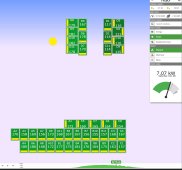Just for fun, here you can see D11 at 12:45pm and 2:15pm. Theres a SHARP ramp up in power from 1:45pm to 2:00pm though. Exactly when the last cell is unshaded. You can also see total recovered at the top right, 7.1kWh extra that I wouldn't have gotten without the Tigo Optimizers.
For more info, the bottom array is South/South East, the top left is South/South West, and the top right is North/North East. Each Group (A, B, C, and D) are in series, and A+B are in parallel, and C+D are in parallel. You can see even with the very mixed orientations of the panels in series (Group C in particular) the output is still very good.




